how should a beginner start running & How to start running today: a beginner's guide
How to start running today: a beginner's guide
Whether you want to start getting active or are keen to run faster, our plans have got you covered
Getting out the door is the hardest part of running. But once you build routine into your life you'll find yourself itching to get out. You may be a beginner with no experience but that doesn't mean running isn't for you.
‘You have to start where you are, not where you think you should be,’ says running coach and exercise physiologist Janet Hamilton. It's all about building up gradually and allowing the body to adapt.
‘If you go further or faster than you’re ready for, your body can’t adapt quickly enough and you’ll get injured.’ Following a plan that is right for you and your goals is really important to ensure you stay motivated and can track your progress.
We've developed a five-part programme with expert coach Sam Murphy to help you take your first steps and move towards your first race.
Let's get started!
1.Your goal is to: get motivated
‘Once it’s a habit, exercise feels easier and doesn’t take as much willpower when you don’t feel like it,’ says Charles Duhigg, author of The Power of Habit.
Make a plan: Duhigg says every habit is made up of a group of cues (time, place, music, other people); a reward (chocolate, massage, smoothie); and a routine (the workout). Write down your cues and rewards and post your plan somewhere you can see it.
Keep it regular: Run at the same time of day and listen to the same pre-workout music. ‘The cues have to be consistent,’ says Duhigg. ‘You’re creating neural pathways that make the activity a habit.’
Reward yourself: Treat yourself to something you enjoy straight after you exercise, so your brain associates exercise with an immediate reward. ‘You have to teach the brain through experience,’ says Duhigg.
2. Your goal is to: just get moving
Before your first run, get in the regular exercise habit by walking. This should be a brisk walk – ‘not a race walk, but not a window-shopping walk either’, says Steven Blair, professor of exercise science at the University of South Carolina, US. You can also use a stationary bike or elliptical trainer, but walking is an excellent foundation for running and holds the convenience trump card. ‘The best exercise is the one you will do consistently,’ says Blair.
A 7 week* walking plan to get your body ready for running:
First Workout: 15 mins
Goal Workout: 60 mins
Are you ready? This plan is for anyone who has yet to exercise at all. It involves only walking, to give your bones, muscles, tendons and fitness the base they need to progress to running without injury.
Room to manoeuver: No time for a longer session? Split the week’s longest in half between morning and afternoon.
*If your BMI is 35 or higher, you’re over 60, or just want gradual progression, use this plan for eight to 12 weeks.
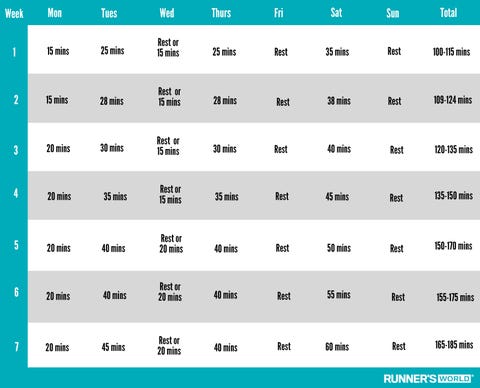
3. Your goal is: to start running
You’re ready to run. And here’s the good news: because you’ll be moving faster, you’ll cover longer distances without adding workout time to your schedule. At the end of this seven-week plan, you’ll be able to complete 175 minutes of exercise per week, running for approximately twice as long as you walk.
A 7-week run-walk plan for beginner runners:
Length of plan: 7 weeks
First workout: Walking for 30 minutes
Goal workout: One hour with run/walk ratio of 2:1
Are you ready? This plan is for the already active, including Stage 1 finishers. In the first two weeks, you’ll exercise for roughly 30 minutes, five days per week. Then, in week 3, you’ll start running.
Room to manoeuvre: If you find yourself ready for a bit more of a challenge, you can pick up the pace: On any given day, work out for the same amount of time, but gradually build to a run/walk ratio of 4:2 minutes, then 6:3 minutes. If you find the plan is moving too quickly for you and want to dial it back, you can repeat any week for as long as you like, until you feel ready to push on.
4. Your goal is to: run non-stop
Want to build your endurance and eliminate the walk breaks? This plan takes you from run/walking up to continuous running. Each run should be done at a conversational pace. If you’re gasping, slow down.
A 7-week beginner running plan to help you run your first 5k:
Length of plan: 7 weeks
First workout: 30 minutes, with 20 minutes at 3:2 run/walk ratio.
Goal workout: Run 3.1 miles (5K) continuously
Are you ready? To begin this plan, you should have spent at least six weeks run/walking for roughly 30 minutes, five days per week, and running at least twice the amount of time you spend walking.
Room to manoeuvre: There’s flexibility in this plan: if it’s too easy, skip ahead to the next week. If your body’s response tells you that the training is moving too fast, spend two weeks or more at each week – although ideally, you’ll complete the programme within a maximum of 14 weeks in total.
5. Your goal is to: run longer
You’ve run a non-stop 5K, now you want to run further. This plan will help you develop the endurance you need to run a 10K, and build the strength to race a 5K. It includes some hills and loosely structured speedwork (fartleks) to build that strength.
A 7-week plan to take you from 5K to 10K:
Length of plan: 7 weeks
First workout: 2-mile run
Goal workout: Run 6-7 miles continuously so you can either race a 5K or finish a 10K
Are you ready? You should have been running for at least 30 minutes, five days per week for at least six weeks, and be able to run three miles or 5K without walking.
Room to manoeuvre: If you’re ready for a greater challenge, skip ahead a week. But don’t rush it. It’s better to build gradually so your body gets used to the extra load, rather than push too hard and risk time on the sidelines with injury. If you feel the plan’s moving too fast, you can repeat any week until you’re ready to progress. Though ideally, you’ll complete this plan in 14 weeks.
6. Your goal is to: get faster
This eight-week plan is for those who can already run five or six miles and want to boost their speed. It will develop endurance, introduce you to speedwork to boost your leg and lung power, and develop ‘pace awareness’ to help you avoid going out too fast.
An 8-week plan to help beginner runners get faster:
Length of plan: 8 weeks
First workout: 2 miles easy
Goal workouts: 8-mile run; 4x800 @5K pace
Are you ready? This plan is for ‘advanced beginners’. To qualify for that title, you should already be running a total of around 18 miles per week, including a five-mile long run.
Room to manoeuvre: If time pressures mean you can only run four days a week rather than the prescribed five, you can skip the shortest easy run of the week. There’s flexibility in when you fit the other sessions in, too. Most runners tend to do their long runs at the weekends, free from the demands of the nine-to-five – but you can shift days and run long midweek if it better suits your routine.
The keys to success:
Get checked: If you’re over 40, have a BMI of 35 or higher, or family history of heart disease, talk to your doctor before you start exercising.
Get good gear: Resist the lure of the old trainers languishing in your wardrobe – even for walking. Worn-out or ill-fitting shoes are a recipe for injury. Go to a specialist running shop to get a pair with the fit and support you need. ‘There’s no magical shoe that makes running easier, but a bad shoe will ruin your running,’ says physiotherapist Bruce Wilk. Also, invest in socks made from technical sweat-wicking fabric to avoid getting nasty blisters. Take a peak at these beginner-friendly running shoes.
Sneak in activity: Take 15 minutes of your lunch break to walk the office corridors; set an alarm every hour to remind you to get up. A study in the International Journal of Behavioural Nutrition and Physical Activity found taking a five-minute walk break once an hour burns 132kcal over an eight-hour day.
Find your place: Map out a few safe, scenic, traffic-free routes that you can cover in various weather conditions and times of day. There are some great running apps to help you plot quiet routes.
Find your pace: When you first start running, the trick is to be consistent enough to build strength and endurance, but slow enough that you don’t get injured. So, do all of your training at an easy pace. Get into a rhythm that feels like you could maintain it for ever. ‘A lot of runners try to run too fast, because they feel like they’re not a runner unless they go at X pace,’ says coach Jeff Gaudette. ‘Your pace needs to be comfortable. If you run faster than you should, it’s going to hurt all the time and you’ll never get to a point where you can do it for 30 minutes.’ Develop the endurance; speed will come later.
Stay flexible: It is OK to split workouts into two or three sessions at first. Studies have shown that three 10-minute exercise sessions deliver the same health boost as a single 30-minute workout, says Blair.
Log your miles: Use a trusty notebook and pencil, or go tech with a GPS – either way you’ll draw confidence from watching the miles rack up. The Garmin Forerunner 45 is affordable and has a run-walk timer.
Take your pulse: Take your resting heartrate for one minute first thing in the morning, before you get out of bed. As you get fitter, you’ll get the motivational boost of seeing your resting heartrate get lower as your heart gets stronger. ‘This shows you that your body is responding to the training,’ says exercise physiologist Susan Paul.
Practise patience: Many of the positive changes that are happening to your body won’t yet be visible in the mirror or on the scales, but don’t panic. ‘Trust that the weight loss will come, and be aware that it takes time to condition your muscles, ligaments and tendons,’ says Paul.


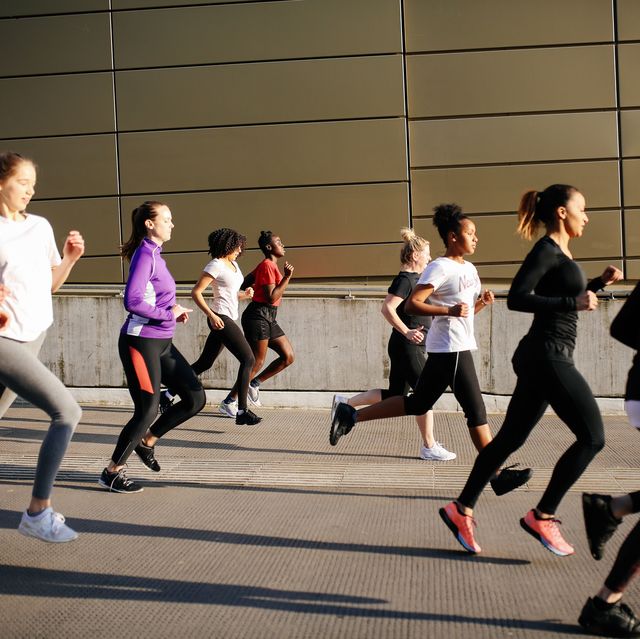
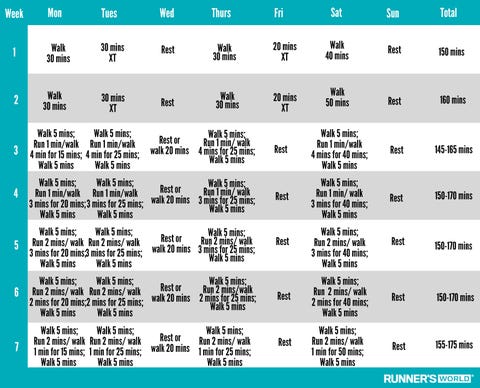
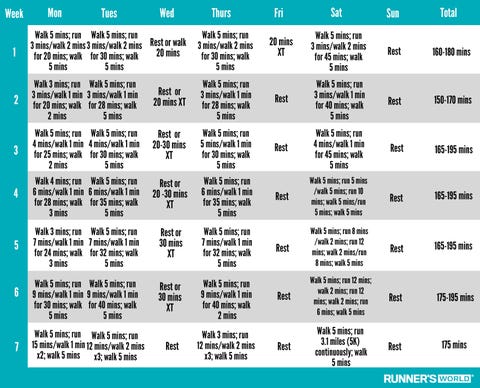
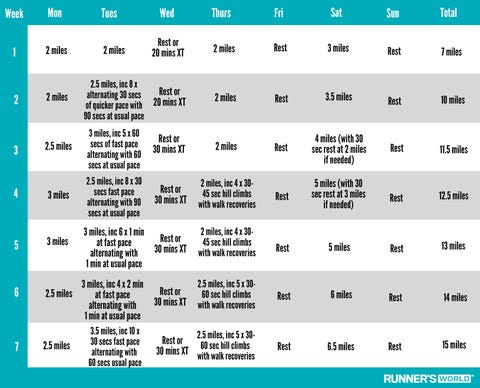




Post a Comment